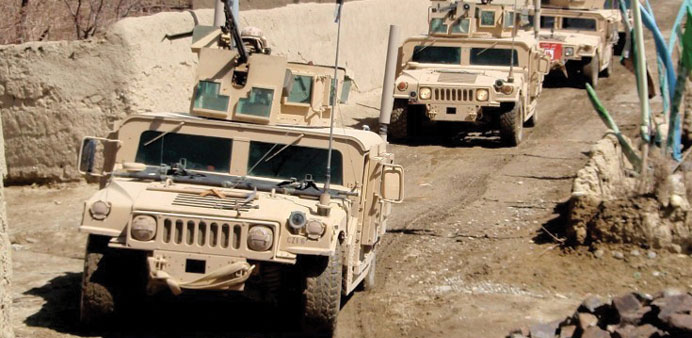Reuters/Kabul
When two US-made Humvees approached a checkpoint in Afghanistan’s Helmand province last month, the police assumed them to be friendly local or coalition forces.
In fact, Taliban militants were behind the wheel of the sand-coloured vehicles. Caught by surprise, police stood no chance against the Humvees’ mounted machine guns.
Fourteen security personnel were killed and at least seven wounded in the attack in the Musa Qala district of the southern province, said Omar Zwak, spokesman for the provincial governor.
The Humvees are among dozens of armed US vehicles that officials say have been captured by insurgents from Afghan forces this year.
The stolen equipment is dwarfed by the thousands of vehicles the Afghan army and police have at their disposal, and incidents like the one in Helmand have been relatively rare.
But the thefts and threat of Western weapons being turned on them worry Afghan commanders, as they struggle to counter a 14-year insurgency to topple the government and reinstate the Taliban’s hardline Islamist regime in Kabul.
“They frequently use them (Humvees) against us on the frontline, especially the heavy machine guns mounted on them,” said Abdullah Danishy, deputy governor of Kunduz province in the north, scene of fierce fighting this year.
As the militants intensify their offensive after the withdrawal of most foreign troops at the end of last year, they are using stolen vehicles to ferry fighters and equipment in battle, as well as to conduct sporadic surprise raids.
The United States spent more than $5.5bn on military equipment, including Humvees, for Afghan forces between 2002 and April 2013, according to a US government report.
In 2011 alone, US manufacturer AM General was due to supply more than 7,100 Humvees to Afghan forces.
There is disagreement over the number of Humvees captured by the Taliban.
A senior Afghan official said “dozens” had been lost, and that the seized vehicles posed “a big threat to our forces and they must be destroyed or recaptured”.
An Afghan lawmaker from Helmand said 30-35 Humvees were captured by the Taliban in a recent battle in that province alone, while Mirdad Nejrabi, chairman of the Afghan parliament’s security committee, said seizures had increased this year.
Coalition forces in Afghanistan referred questions on the matter to the defence and interior ministries.
The interior ministry said it had “lost” nine Humvees in the battlefield since the start of 2015, either destroyed or captured. The defence ministry did not respond to requests for comment.
According to Taliban spokesman Zabihullah Mujahid, the group has seized many vehicles, although he declined to give a number.
“These vehicles are important for us in the battlefield and we have no problem using them everywhere,” Mujahid said.
Adding to the embarrassment of the losses, the Taliban has used the seizures in propaganda videos featuring Humvees spray painted with the movement’s logo and manned by insurgents.
One was filmed in Kunduz’s Chardara district, which the Taliban briefly took control of earlier this year, threatening the provincial capital. While not dated, the video was issued in August and is believed to be recent.
Other military hardware has fallen in the hands of opposing forces in Afghanistan, a common phenomenon in any conflict, but some Afghan officials said Humvees posed a particular threat because they could be used for a variety of roles by the Taliban, including sneak attacks.
Abdullah, the head of Afghan special operations in Kunduz who goes by one name, said the Taliban can use captured vehicles only for a few weeks, because they did not have the spare parts to keep them running.
“Humvees require professional use. The Taliban can only enjoy driving them for a few weeks,” Abdullah said.
But Mujahid countered that the group had been able to glean tips on how to use and maintain the vehicles from the Internet, as well as from captured Afghan soldiers. He said fighters also stripped older Humvees down for spare parts.
Taliban militants who gained access to an Afghan army post through a collaborator killed 10 soldiers yesterday, officials said, in the latest example of an “insider attack” on government forces.
Lutfollah Azizi, governor of the northern province of Jawzjan where the incident took place at around 2am, said 14 soldiers were stationed at the checkpoint, including one infiltrator who allowed the attackers to enter.
“After killing four soldiers using a hand grenade, the Taliban detained the others by tying their hands behind their backs. They then executed six more, while three managed to escape,” Azizi said.
The attack was confirmed by provincial police chief Faqir Mohamad Jawzjani.
Jawzjan province, which borders Turkmenistan, has largely been spared the worst of the violence from a bloody Taliban insurgency now in its 14th year.
But some of its districts, including Qush Tepah where the attack took place, have seen a rising Taliban presence.
The attack came as the Taliban’s new leader Mullah Mansour told the government it must cancel a security deal with the United States and expel all foreign troops if it wants peace.

A convoy of Humvees.
